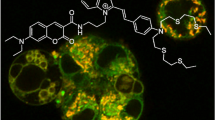Summary
Cisplatin (CDDP)-sensitive and -resistant human ovarian cells were studied in vitro with the objective of enhancing CDDP cytotoxicity by the addition of a metal and the chelate ethylenediaminetetraacetic acid (EDTA), to the CDDP. Chelateable elements, such as bismuth, calcium, cadmium, copper, iron, magnesium, selenium, vanadium, and zinc, when added to CDDP and in the presence of EDTA increased the cytotoxicity of the CDDP as compared to CDDP treatment alone.
Similar content being viewed by others
References
Andrews, P. A.; Howell, S. B. Cellular pharmacology of cisplatin: perspectives on mechanisms of acquired resistance. Cancer Cells 2:35–43; 1990.
Borenfreund, E.; Puerner, J. A. Toxicity determined in vitro by morphological alterations and neutral red absorption. Tox. Let. 24:(2–3):119–24; 1985.
Borenfreund, E.; Puerner, J. A. Cytotoxicity of metals, metal-metal and metal-chelator combinations assayed in vitro. Toxicology 39:121–134; 1986.
Cannistra, S. A. Cancer of the ovary. N. Engl. J. Med. 329:1550–1559; 1993.
Cherian, M. G.; Howell, S. B.; Inura, N., et al. Role of metallothionein in carcinogenesis. Toxicol. Appl. Pharmacol. 126:1–5; 1994.
Dwyer, F. P.; Mellor, D. P. Chelating agents and metal chelates. New York: Academic Press; 1964:17–27.
Eastman, A. The formation, isolation and characterization of DNA adducts produced by anticancer platinum complexes. Pharmacol. & Ther. 34:155–166; 1987.
Farrell, N. Structurally novel platinum antitumor compounds. In: Howell, S. B., ed. Platinum and other metal coordination compounds in cancer chemotherapy. New York: Plenum Press; 1991:81–92.
Kondo, Y.; Satoh, M.; Imura, N., et al. Tissue-specific induction of metallothionein by bismuth as a promising protocol for chemotherapy with repeated administration of cis-diamminedichloroplatinum (II) against bladder tumor. Anticancer Res. 12:2303–2308; 1992.
Lemaire, M. A.; Schwartz, A.; Rahmouni, A. R., et al. Interstrand cross-links are preferentially formed at the d(GC) sites in the reaction between cis-diamminedichloroplatinum (II) and DNA. Proc. Natl. Acad. Sci. 88:1982–1985; 1991.
Loehrer, P. J.; Einhorn, L. H. Cisplatin. Ann. Intern. Med. 100(5):704–713; 1984.
Murthy, M. S.; Rao, L. N.; Khandekar, J. D., et al. Enhanced therapeutic efficacy of cisplatin by combination with diethyldithiocarbamate and hyperthermia in a mouse model. Cancer Res. 47:774–779; 1987.
Naganuma, A.; Satoh, M.; Imura, N. Prevention of lethal and renal toxicity of cis-diamminedichloroplatinum (II) by induction of metallothionein synthesis without compromising its antitumor activity in mice. Cancer Res. 47:983–987; 1987.
Nicholson, D. L.; Maier, R. H.; Pories, W. J. Zinc-enhanced cytotoxicity in cisplatin sensitive and resistant human ovarian cancer cells. In Vitro Cell. Dev. Biol. 29A:625–626; 1993.
Nicholson, D. L.; Maier, R. H.; Pories, W. J. Differential cytotoxicity of metal chelating agents in cisplatin sensitive and resistant human ovarian cancer cells. Trace Elem. Med. 10:188–191; 1993.
Parker, R. J.; Eastman, A.; Bostick-Bruton, F., et al. Acquired cisplatin resistance in human ovarian cancer cells is associated with enhanced repair of cisplatin-DNA lesions and reduced drug accumulation. J. Clin. Invest. 87(3):722–727; 1991.
Satoh, M.; Kloth, D.; Kadhim, S., et al. Modulation of both cisplatin nephrotoxicity and drug resistance in murine bladder tumor by controlling metallothionein synthesis. Cancer Res. 53:1829–1832; 1993.
Timmer-Bosscha, H.; Mulder, N. H.; deVries, E. G. E. Modulation of cisdiamminedichloroplatinum (II) resistance: a review. Br. J. Cancer 66(2):227–238; 1992.
Trissel, L. Handbook on injectable drugs. Am. Soc. of Hosp. Pharm. Bethesda, MD: 161–163; 1986.
Weiss, R. B.; Christian, M. C. New cisplatin analogues in development—a review. Drugs 46(3):360–377; 1993.
Withrow, S. J.; Powers, B. E.; Straw, R. C., et al. Comparative aspects of osteosarcoma: dog versus man. Clinical Orthopaedics and Related Research 270:159–168; 1991.
Young, R. Mechanisms to improve chemotherapy effectiveness. Cancer 65(1):815–822; 1990.
Author information
Authors and Affiliations
Rights and permissions
About this article
Cite this article
Maier, R.H., Purser, S.M., Nicholson, D.L. et al. The cytotoxic interaction of inorganic trace elements with EDTA and cisplatin in sensitive and resistant human ovarian cancer cells. In Vitro Cell.Dev.Biol.-Animal 33, 218–221 (1997). https://doi.org/10.1007/s11626-997-0145-8
Received:
Accepted:
Issue Date:
DOI: https://doi.org/10.1007/s11626-997-0145-8




